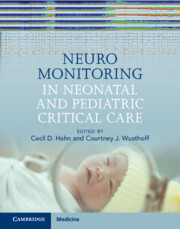Book contents
- Neuromonitoring in Neonatal and Pediatric Critical Care
- Reviews
- Neuromonitoring in Neonatal and Pediatric Critical Care
- Copyright page
- Contents
- Contributors
- Acknowledgements
- Part I General Considerations in Neuromonitoring
- Part II Practice of Neuromonitoring: Neonatal Intensive Care Unit
- Part III Practice of Neuromonitoring: Pediatric Intensive Care Unit
- Part IV Practice of Neuromonitoring: Cardiac Intensive Care Unit
- Chapter 13 Perioperative Monitoring for Congenital Heart Disease Surgery
- Chapter 14 EEG Monitoring in Neonates and Children Undergoing Extracorporeal Membrane Oxygenation
- Chapter 15 Neuromonitoring after Cardiac Arrest
- Part V Cases
- Index
- References
Chapter 15 - Neuromonitoring after Cardiac Arrest
from Part IV - Practice of Neuromonitoring: Cardiac Intensive Care Unit
Published online by Cambridge University Press: 08 September 2022
- Neuromonitoring in Neonatal and Pediatric Critical Care
- Reviews
- Neuromonitoring in Neonatal and Pediatric Critical Care
- Copyright page
- Contents
- Contributors
- Acknowledgements
- Part I General Considerations in Neuromonitoring
- Part II Practice of Neuromonitoring: Neonatal Intensive Care Unit
- Part III Practice of Neuromonitoring: Pediatric Intensive Care Unit
- Part IV Practice of Neuromonitoring: Cardiac Intensive Care Unit
- Chapter 13 Perioperative Monitoring for Congenital Heart Disease Surgery
- Chapter 14 EEG Monitoring in Neonates and Children Undergoing Extracorporeal Membrane Oxygenation
- Chapter 15 Neuromonitoring after Cardiac Arrest
- Part V Cases
- Index
- References
Summary
The period following resuscitation after cardiac arrest is a critical time during which the identification and management of neurological injury may lead to increased survival and improved long-term functional outcomes. Neuromonitoring can guide patient management and aid in prognostication following cardiac arrest. EEG background patterns may be useful in outcome prognostication for some patients within 24 hours of cardiac arrest. Similarly, EEG monitoring is often employed for detection of seizures after pediatric cardiac arrest; seizures are common and are most often subclinical. Hypothermia may impact the interpretation and optimal timing of neuromonitoring data used for prognostication. Experts recommend a multimodal approach to prognostication. In this chapter, we discuss cEEG monitoring, quantitative EEG methods for seizure identification, and EEG background interpretation. We discuss SSEPs and NIRS and their respective roles in neurological management and prognostication. We also address how therapeutic hypothermia (TH) and medication exposure can change the reliability of some of these neuromonitoring tools.
Keywords
- Type
- Chapter
- Information
- Neuromonitoring in Neonatal and Pediatric Critical Care , pp. 189 - 204Publisher: Cambridge University PressPrint publication year: 2022



